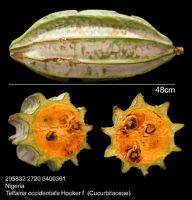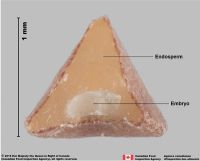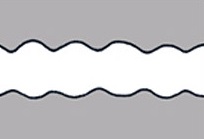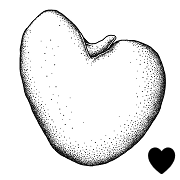Content is from Kirkbride et al. 2006Kirkbride et al. 2006:
Kirkbride JH, Jr, Gunn CR, and Dallwitz MJ. 2006. Family guide for fruits and seeds, vers. 1.0. Accessed September 2020-January 2022. URL: https://nt.ars-grin.gov/seedsfruits/keys/frsdfam/index.cfm ., without modification.
Updates are forthcoming.
Fruits: Pistil(s) compound, or simplesimple:
fruit formed from a single flower with one pistil, solitary carpel or several fused carpels
; 1; 1-pistillate; with carpels united. Fruit pericarpium; simplesimple:
fruit formed from a single flower with one pistil, solitary carpel or several fused carpels
; capsulecapsule:
a dry, dehiscent fruit derived from a compound ovary ; loculicidalloculicidal:
; loculicidalloculicidal:
type of capsular dehiscence, opening longitudinally through the locules (compare septicidal)
 capsulecapsule:
capsulecapsule:
a dry, dehiscent fruit derived from a compound ovary ; capsulecapsule:
; capsulecapsule:
a dry, dehiscent fruit derived from a compound ovary not inflated; capsulecapsule:
not inflated; capsulecapsule:
a dry, dehiscent fruit derived from a compound ovary without operculumoperculum:
without operculumoperculum:
a dehiscent cap (or lid) of a seed or fruit that opens during germination or dehiscence
 ; without persistent central column; with styles(s); at apexapex:
; without persistent central column; with styles(s); at apexapex:
the point farthest from the point of attachment, or the "tip" of an organ ; within accessory organ(s); within bracts, or cupule; connate; persistent; 1-seeded; 1-seeded; with (1–)3(–5)-carpellate ((1-)3–4(5)); with carpels united; with carpels remaining united at maturity; with carpels not radiating at maturity; without sterilesterile:
; within accessory organ(s); within bracts, or cupule; connate; persistent; 1-seeded; 1-seeded; with (1–)3(–5)-carpellate ((1-)3–4(5)); with carpels united; with carpels remaining united at maturity; with carpels not radiating at maturity; without sterilesterile:
lacking male and/or female reproductive parts; also, not producing fruit or seed
 carpels; not sulcatesulcate:
carpels; not sulcatesulcate:
surface relief—having one or more elongate, relatively narrow and shallow depressions or grooves ; in transectiontransection:
; in transectiontransection:
a cross section; representing a plane made by cutting across an organ at a right angle to its length tereteterete:
tereteterete:
approximately circular in cross section; width and thickness approximately equal
 ; apexapex:
; apexapex:
the point farthest from the point of attachment, or the "tip" of an organ not beaked; indehiscentindehiscent:
not beaked; indehiscentindehiscent:
not opening on its own, as in a fruit
 , or dehiscentdehiscent:
, or dehiscentdehiscent:
(v. dehisce) splitting open at maturity to release contents (of a fruit) . Dehiscentdehiscent:
. Dehiscentdehiscent:
(v. dehisce) splitting open at maturity to release contents (of a fruit) unit seed(s). Dehiscentdehiscent:
unit seed(s). Dehiscentdehiscent:
(v. dehisce) splitting open at maturity to release contents (of a fruit) and shedding seeds; without replumreplum:
and shedding seeds; without replumreplum:
the rim, formed by the persistent placentas, and connected by a false septum in Brassicaceae fruits. The fruit valves are attached to this rim and separate from it in dehiscent fruits.
. Epicarpepicarp:
outer layer of fruit wall or pericarp, if divided into layers; note here used synonymously with exocarp durable; glabrousglabrous:
durable; glabrousglabrous:
without hairs
; without armature; smooth; without wing(s); without apicalapical:
at or pertaining to the end of the seed or fruit distal from its point of attachment (i.e., base)
respiratory hole. Endocarpendocarp:
the inner layer of the pericarp, if divided into layers present; not separating from exocarpexocarp:
present; not separating from exocarpexocarp:
outer layer of fruit wall or pericarp, if divided into layers; note here used synonymously with epicarp ; thinthin:
; thinthin:
having or being of relatively little depth
; not splitting into 1-seeded pyrenes; smooth; without wing; without operculumoperculum:
a dehiscent cap (or lid) of a seed or fruit that opens during germination or dehiscence
 ; without secretory cavities; without mechanism for seedling escape; without grooves; without longitudinallongitudinal:
; without secretory cavities; without mechanism for seedling escape; without grooves; without longitudinallongitudinal:
of or relating to length or the lengthwise dimension
ridges. Funiculusfuniculus:
(alt. funicle) stalk connecting the ovule (later seed) to the ovary (later fruit) placenta short; short without seed bearing hooks (retinacula); not persisting in fruit after seed shed.
short; short without seed bearing hooks (retinacula); not persisting in fruit after seed shed.
Seeds: Arilaril:
(broad sense) appendicular structure that wholly or partly envelops a seed and is produced from or a modification of the funicle, raphe, or outer integument; usually fleshy or pulpy, sometimes spongy or tufted-capillate, often brightly colored absent. Seed not bowl shaped; not nutlike; without winglike beakbeak:
absent. Seed not bowl shaped; not nutlike; without winglike beakbeak:
a usually firm, terminal appendage, sometimes tapered ; without caudatecaudate:
; without caudatecaudate:
tapering to a long, tail-like appendage appendage(s); at maturity with food reserves, or without food reserves (rarely), or without apparent food reserves; with endospermendosperm:
appendage(s); at maturity with food reserves, or without food reserves (rarely), or without apparent food reserves; with endospermendosperm:
nutritive starch- and oil-containing tissue present in many seeds ; without canavanine. Sarcotestasarcotesta:
; without canavanine. Sarcotestasarcotesta:
pulpy or fleshy outer layer of the seed coat, simulates aril absent. Testatesta:
absent. Testatesta:
seed coat
 present; without markedly different marginalmarginal:
present; without markedly different marginalmarginal:
at, on, or close to the margin or border
tissue; without fleshyfleshy:
texture—fairly firm and dense, juicy or at least moist, and easily cut
or leatheryleathery:
texture—moderately thick, tough, and very pliable
layer over hard layer; loose; dulldull:
reflecting only a low proportion of incident light, with no apparent sheen (assumed); surface unsmooth; surface with merged raised features; surface rugoserugose:
(assumed); surface unsmooth; surface with merged raised features; surface rugoserugose:
=wrinkled ; without glands; without bristles; glabrousglabrous:
; without glands; without bristles; glabrousglabrous:
without hairs
; without wings; without collar; without operculumoperculum:
a dehiscent cap (or lid) of a seed or fruit that opens during germination or dehiscence
 ; colored; monochrome; coriaceouscoriaceous:
; colored; monochrome; coriaceouscoriaceous:
texture—leathery
; not becoming mucilaginousmucilaginous:
resembling mucilage; moist and sticky
when wetted; surrounding food reserve, or surrounding embryo. Endospermendosperm:
nutritive starch- and oil-containing tissue present in many seeds copious; fleshyfleshy:
copious; fleshyfleshy:
texture—fairly firm and dense, juicy or at least moist, and easily cut
, or hard; with starch; without fatty acid containing cyclopropene; without apicalapical:
at or pertaining to the end of the seed or fruit distal from its point of attachment (i.e., base)
lobes; without chlorophyll; without isodiametric faceted surface; without odor. Embryo differentiated from food reserve; well developed; 1 per seed; partially filling testatesta:
seed coat
 (with food reserve), or nearly filling testatesta:
(with food reserve), or nearly filling testatesta:
seed coat
 (trace or scanty food reserve), or completely filling testatesta:
(trace or scanty food reserve), or completely filling testatesta:
seed coat
 (no food reserve); 0.5–1 times the length of food reserve; at one end of seed not extending into a depression or cup; axileaxile:
(no food reserve); 0.5–1 times the length of food reserve; at one end of seed not extending into a depression or cup; axileaxile:
on or of the axis
and centric; foliatefoliate:
appearing leaf-like
; with spatulatespatulate:
2D shape—like a spatula; rounded at the apex, with base long and tapered; (of embryo) embryo is straight and axile and centric with the cotyledons expanded to form the shape of a spatula or spoon; (of cotyledons) cotyledons expanded and wider than the stalk but not invested into the stalk cotyledons, or investinginvesting:
cotyledons, or investinginvesting:
(of embryo) embryo is nearly or completely filling seed coat, straight, and axile and centric with spatulate cotyledons and covering the stalk for at least half its length; (of cotyledons) cotyledons spatulate and covering the stalk for at least half its length
cotyledons; straight; parallel to seed length; embedded in endospermendosperm:
nutritive starch- and oil-containing tissue present in many seeds ; with cotyledons abruptly connected to hypocotyl-radicle; without coleorhiza; without simmondsin; without stomata; not green; with 2 or more cotyledons. Cotyledons 2; well developed, or moderately developed; 0.5 times length of embryo; somewhat to significantly wider than hypocotyl-radicle; 2 times wider than hypocotyl-radicle; partially concealing hypocotyl-radicle, or not concealing hypocotyl-radicle; foliaceous; thinthin:
; with cotyledons abruptly connected to hypocotyl-radicle; without coleorhiza; without simmondsin; without stomata; not green; with 2 or more cotyledons. Cotyledons 2; well developed, or moderately developed; 0.5 times length of embryo; somewhat to significantly wider than hypocotyl-radicle; 2 times wider than hypocotyl-radicle; partially concealing hypocotyl-radicle, or not concealing hypocotyl-radicle; foliaceous; thinthin:
having or being of relatively little depth
, or thickthick:
having or being of relatively great depth
; flat, or undulateundulate:
wavy-margined
 , or plicate; undulateundulate:
, or plicate; undulateundulate:
wavy-margined
 ; with apicesapex:
; with apicesapex:
the point farthest from the point of attachment, or the "tip" of an organ entire; with margins separate; basally cordatecordate:
entire; with margins separate; basally cordatecordate:
2D shape—heart-shaped, with attachment at or near the broad end (compare obcordate) , or entire; equal in size; not punctatepunctate:
, or entire; equal in size; not punctatepunctate:
surface relief—dotted with pits or with translucent, sunken glands or with colored dots, similar to pitted dotted. Hypocotyl-radicle well developed; straight; not thickened.
dotted. Hypocotyl-radicle well developed; straight; not thickened.
 fruit with 1 or few seeds (only 1 carpelcarpel:
fruit with 1 or few seeds (only 1 carpelcarpel:Literature specific to this family: Gérard, F. 1919. Étude systématique, morphologique et anatomique des Chlaenacées. Ann. Inst. Bot.-Géol. Colon. Marseille, sér. 3, 7:1–135; Nebell, G.F. 1811. Zwei neue Pflanzen aus Madagascar, namlich die Sarcolaena grandiflora und Sarcolaena multflora. Allg. Teutsch. Gart.-Mag. 11:85–88, tab 9 & 10.
General references: Baillon, H.E. 1866–95. Histoire des plantes, 13 vols. Hachette & Co., Paris, Cronquist, A. 1981. An integrated system of classification of flowering plants, 1,262 p. Columbia University Press, New York, Engler, A. & K. Prantl. 1924 and onward. Die Natürlichen Pflanzenfamilimien. W. Engelman, Leipzig, Goldberg, A. 1986 (dicots) & 1989 (monocots). Classification, evolution, and phylogeny of the familes of Dicotyledons. Smithsonian Contr. Bot. 58 for dicots (314 pp.) & 71 for monocots (74 pp.). [Goldberg's illustrations are reproduced from older publications and these should be consulted], Gunn, C.R., J.H. Wiersema, C.A. Ritchie, & J.H. Kirkbride, Jr. 1992 & amendments. Families and genera of Spermatophytes recognized by the Agricultural Research Service. Techn. Bull. U.S.D.A. 1796:1–500, Hutchinson, J. 1964. The families of flowering plants, vol. I. Dicotyledons. Clarendon Press, Oxford, Mabberley, D.J. 1987. The plant-book, 706 p. Cambridge University Press, Cambridge, and Spjut, R.W. 1994. A systematic treatment of fruit types. Mem. New York Bot. Gard. 70:1–182.